News
Spring Roundup Time in the 1800s

Spring is a time when ranchers began to gather cattle off the range and brand the calves before turning them out on summer pasture. Today with fenced pastures, it is easier to gather cattle than it was in the late 1800s in Wyoming. Much of Wyoming was still open range, and the spring roundup was a big event for the cattle owners.
The open range was divided into sections, and each section had a foreman or commissioner to run their section of the roundup, and each large ranch would send their ‘reps’ or representatives to make sure that each rancher’s cattle were gathered, and the calves branded.
The roundups were posted in the early newspapers.
This from The Big Horn Sentinel (Buffalo), March 30, 1889 – Annual Meeting of the Johnson County Stock Association. On Monday last the Johnson County Stock association held its ninth annual meeting. The association is in good condition, and the attendance was unusually large, numbers from all parts of Johnson and Sheridan counties being in attendance, the meeting was held at the courthouse.
The following roundup commissioners were appointed for the northern district, and the roundups were fixed as follows Northern Roundup, Hiram Russel, to commence May 15. at the head of Tongue River, on the north side to the canyon.
Move camp to Pratt & Ferris home ranch on Clear Creek, joining the Clear Creek and Crazy Woman roundup, working with it to the mouth of Clear Creek, then move to Murphy Gulch working down the same Prairie Dog to FF ranch, including Cat creek to its mouth, thence down Prairie Dog to its mouth, thence up Badger and Deer Creeks to their heads, thence to the head of Hanging Woman, thence down Hanging Woman; thence up Tongue River on south side to its head, working Big and Little Goose creeks and Wolf creek.

Crazy Woman and Clear Creek round up, W. J. Clarke, foreman. commencing May 20 at the month of Crazy Woman working it and all its tributaries to the head of South fork of Crazy Woman, including the head of Nine Mile thence north to Middle Fork and north Fork of Crazy Woman, including the Buffalo Wallows, and the head of Dry Creek; thence across Clear Creek working Rock Creek, Shell creek, Lake DeSmet and Piney meeting northern roundup on June 10 at Big Red; thence down Piney to its mouth; thence down Clear Creek to its mouth.
Upper Powder River roundup, John Pierce, foreman, commencing May 20 at the head of the north Fork of Powder River working down north and main Powder River to the mouth of Salt creek, thence up middle Fork to N.H. Ranch thence Bar C pasture and through Sioux Pass to Bridger Road; thence down S. Fork Powder River to its mouth; thence to head of Salt Creek and down to it’s mouth, then up Power River to the 15 mile corral.
Divide Roundup, Frank Labertaux foreman, shall commence May 20, on the head of North Fork of Wild Horse and work up the divide to and including Meadow Creek; thence down Dry Fork of Powder River, and then down Power River to the Montana line.
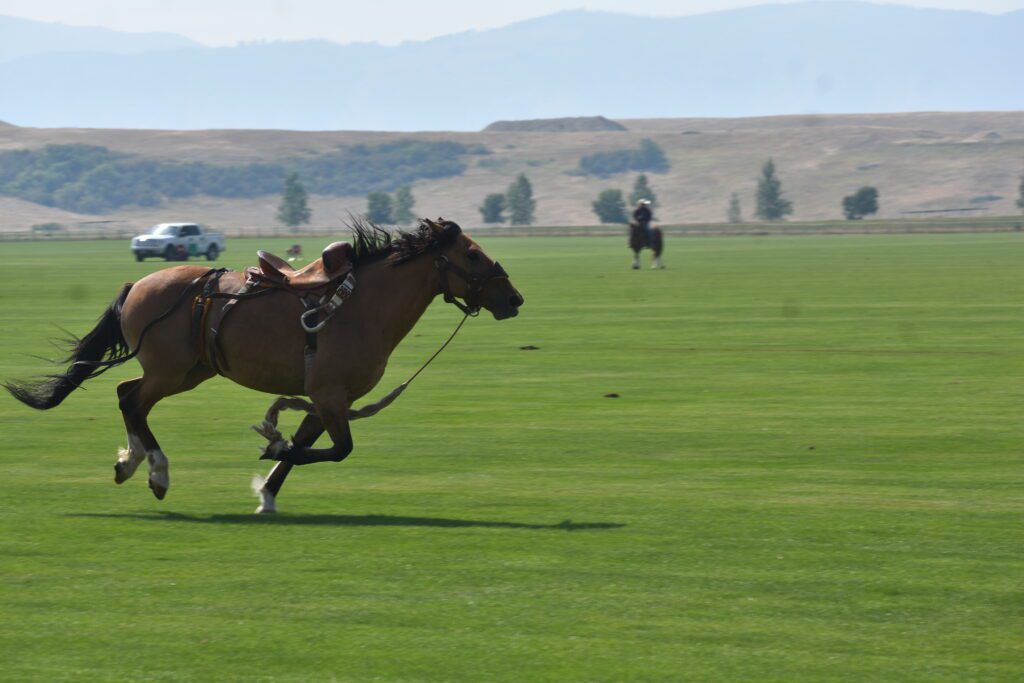
Sheridan, Wyoming, Thursday, March 31, 1892 – Meeting Of Stockmen. The Stockmen of Northern Wyoming met at the club room of Forrest & Lord last evening, and proceeded to arrange for the spring roundup, Capt. E. Cross was made chairman and J.B. Kendrick, secretary. There was a good attendance. and the meeting agreed to try and consolidate the interests of the stockman and farmers, realizing that they are are almost identical, and to use their best efforts to prevent rustling and to promote harmony and security to all. The Crazy Woman Roundup No. 35 commences May 10 at mouth of Crazy Woman, working Crazy Woman and tributaries to Trabing.
There the roundup splits, part working head of Crazy Woman and all country along the mountains to Buffalo, the other part working Buffalo Wallows, Dry Creek and Red Hills to Double Crossing of Clear Creek. Thence work Clear Creek to its mouth, thence work Buffalo creek to its head. Commissioner, J.T. Craig.
The Northern roundup commences by joining the Crazy Woman roundup at Double Crossing of Clear creek May 20, working with said roundup to Dugout on Piney, thence working all country between Pinoy and Clear creek, including Box Elder and Shell Creek, thence work Murphy Gulch, thence work Cat Creek, Dutch Creek to its mouth, Prairie Dog to its mouth, including Cotant Creek and Beattie gulch, thence work Badger creek, Deer Creek and Hanging Woman. Commissioner, Geo. L. Smith.
The Divide roundup commences June 1, in the Red Hills at head of Wild Horse, work head of Wild Horse, thence work all of the divide to Six-Mile pens on Dry Fork Powder river, thence work to Old Fort Reno on Powder river, thence work down Powder river to the Montana line, including LX creek, S. A. creek, Lower Wild Horse and Fence creek. Commissioner, R.L. Gibson.
Wm. Burnett of Buffalo, representing T- 4 brand, appeared before the meeting and asked permission to gather his cattle and remove them from the country. While he admitted that there had been crooked work done with the brand, he denied that it was with his knowledge or consent, and claimed he was with the cattle men, and opposed to the rustlers and rustling in every form. On the condition that be worked in accordance with his statements, he was given permission to gather bis cattle with this roundup.
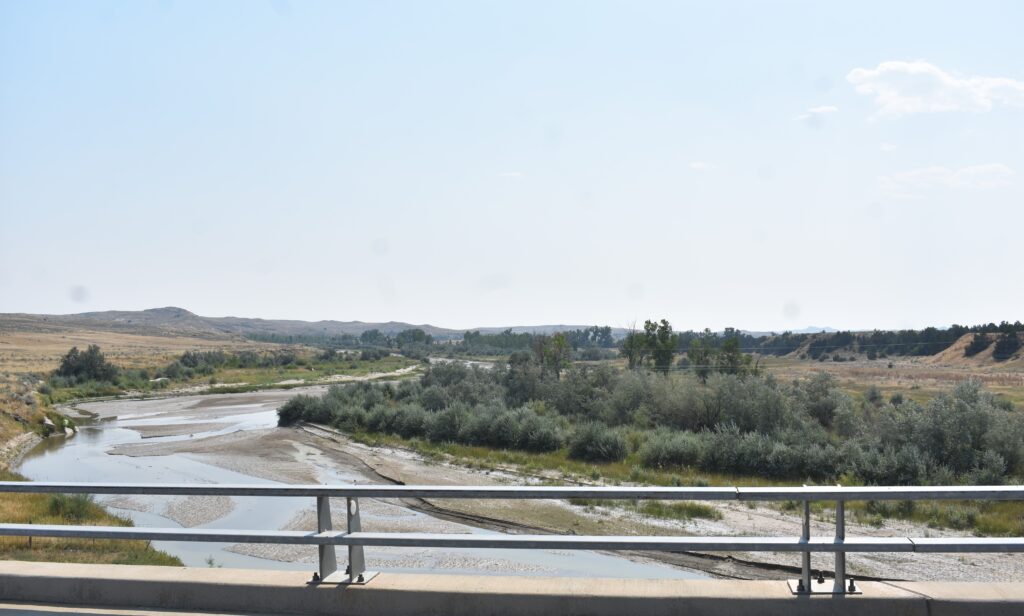
Weston County Democrat, Newcastle, May 26, 1890 – The cow outfits throughout the county are making preparations to start on the northern round-up, which begins at Dayton on the 20th. Old harness is being overhauled, saddles refitted, and the! merchants are doing a rushing business putting up grub for the different outfits. The grass is fine, the cattle in splendid condition and the calves will be so plentiful, strong and frisky that it will make lots of hard work for the boys. — Sheridan Enterprise
From a longer article in The Buffalo Bulletin, on May 5, 1892 – The spring roundup of 1883 was one long to be remembered by the boys who took a hand in that great drive. On the 20 day of May, twenty-seven wagons with a full complement of men and horses met at the mouth of Crazy Woman. Fred Hesse was the foreman of the whole outfit. On that occasion about 1400 head of horses and 40 men were present. The sight was a beautiful one.
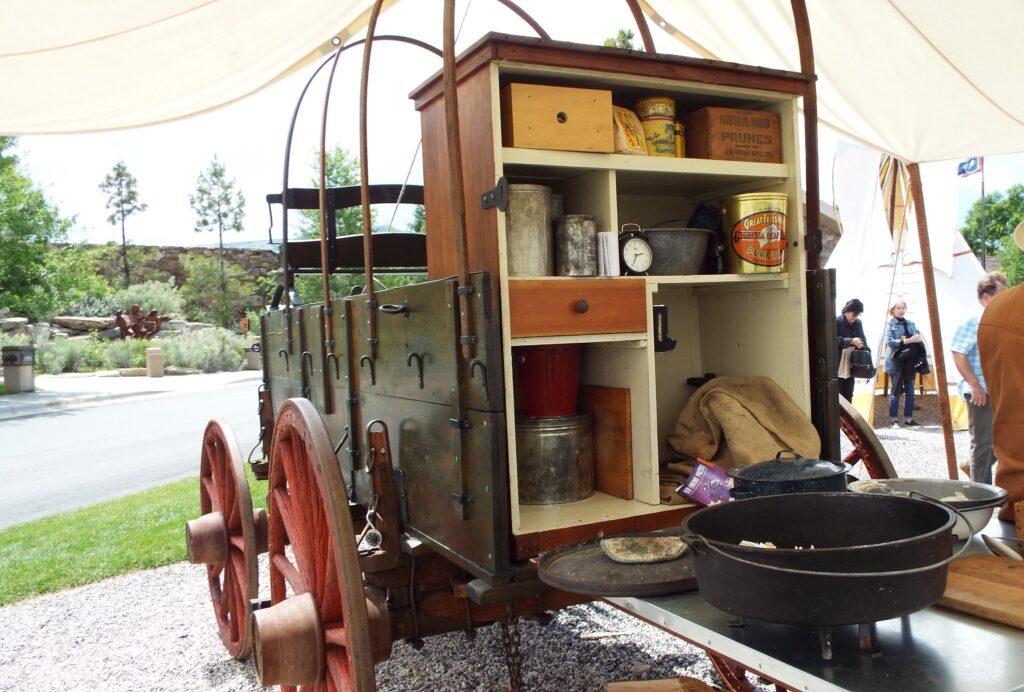
For two miles along the river the wagons were camped, in order to afford room for the different bunches of horses to graze without becoming mixed. About sunrise on the morning of the 21st the men all collected at a certain place designated by the foreman. preparatory to starting on the different drives. This was the first day of the round-up, every man rode his best horse, and each one vied with the other in the splendor of his rig.
This from a longer article in The Meeteetse News, February 2, 1917, about the golden age of the cowboy. – The cattle were all branded and turned loose to run at large on the open range, both winter and summer. To be unmolested only at the time of branding or the gathering of the beef.
The greatest day of the range was the starting of the spring roundup, when all the outfits would at meet at some place agreed upon to start the spring work of branding the calves.
Each outfit would have their mess or roundup wagon equipped with a stove, a good supply of grub, the belongs of the cowboys and other necessaries, all in charge of a cook whose duty it was to drive the wagon and get the meals. The convoy of saddle horses, fifty to a hundred in number, depending upon the number of riders, giving six to eight to the mount, were kept close to the wagon in charge of the horse wrangler whose, duty it was to look after them and at the proper time bring them into camp that the riders might select their horses for the day’s roundup.
The cook was one of the most important member of the round-up crew. He made sure that the chuck wagon was well stocked, and that he was in the lead so he could have the grub ready at the stopping points along the round-up route. He was up early in the morning, making sure there was a pot of coffee over the fire and a hearty breakfast ready for the hands. The ranchers advertised for cooks, and in this case the cook himself advertised for the job.

It could also be a social event, and perhaps the fiddler was appreciated after a long day on the trail.

The above article continues. With the starting of the day’s work the real fun begins. A great many of the horses haven’t had a rope on since the fall before and naturally of a wild and vicious disposition they seem to have made up their minds never to be ridden again.
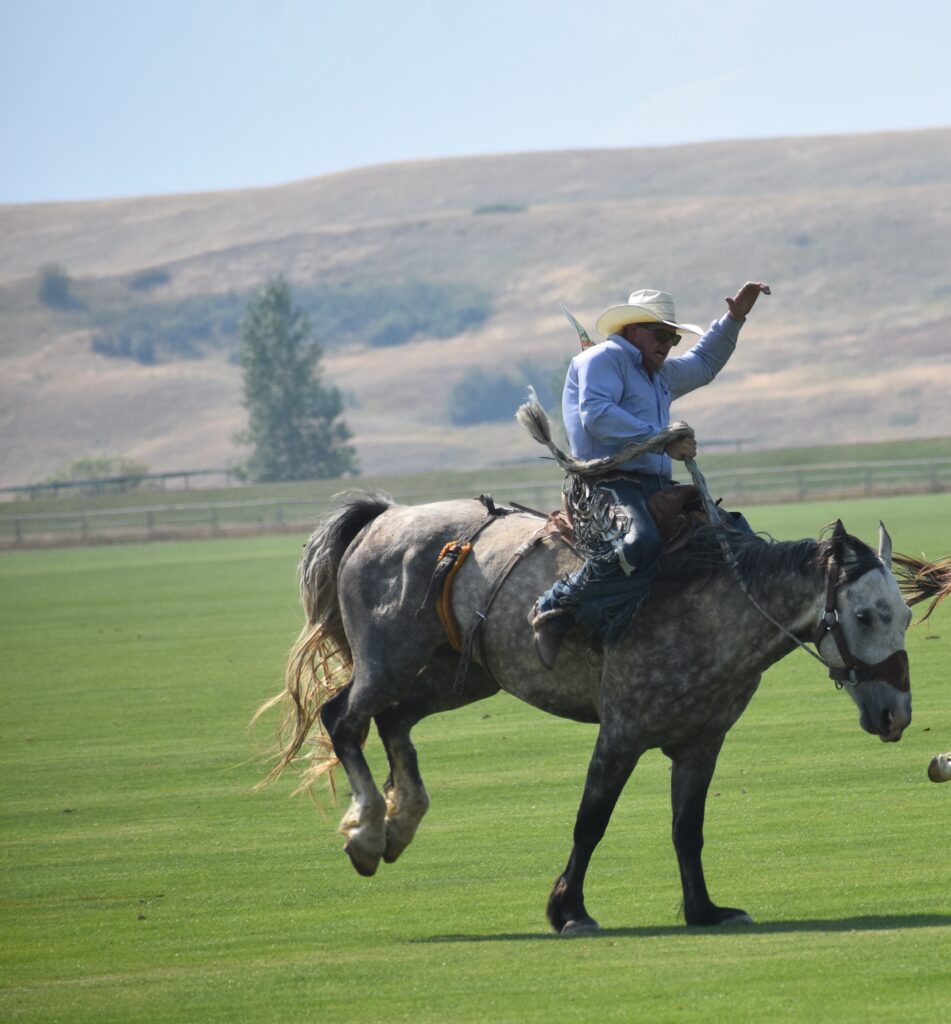
Here is where the real cowboy has a chance to show his courage and training for if he succeeds in riding and conquering his bronc to the approval of the roundup his reputation is pretty well established for the summer.
But if he should he thrown, he would be jeered and laughed at by everybody and made the butt of all the jibes and jokes until something of the same nature happened to another unfortunate- when the honor would be divided.
After the herd is all rounded up and a change is made to fresh horses, real work of the roundup commences. Part of the riders will hold the herd the herd while others gather wood to build a fire for heating the branding irons to be used for burning the brands on the calves.
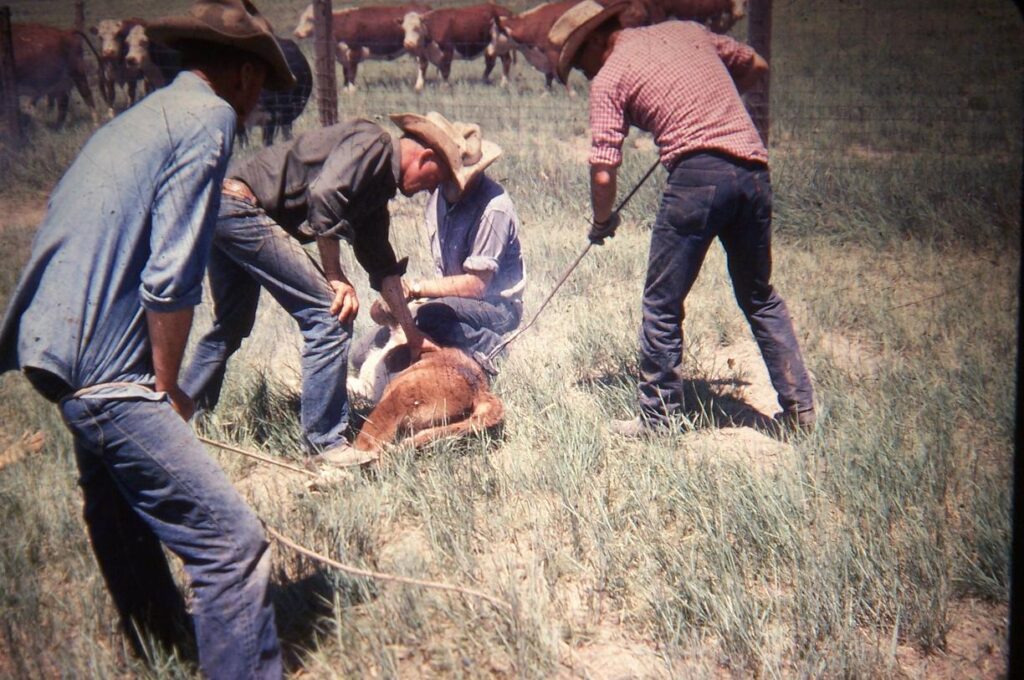
Others will throw and hold the calves to be branded as they are caught and dragged in by the ropers. Here is where they test the real knowledge and art of the cowboy. In a herd of perhaps a thousand cattle he must be able to rope the calves with machine like accuracy and call the brand on the mothers so there will be no mistake made by the men working at the fire. It is considered quite a compliment to be sent into the herd to rope.
All summer long the work will continue in about the same way, in fact until every portion of the country has been gone over and all the calves branded.
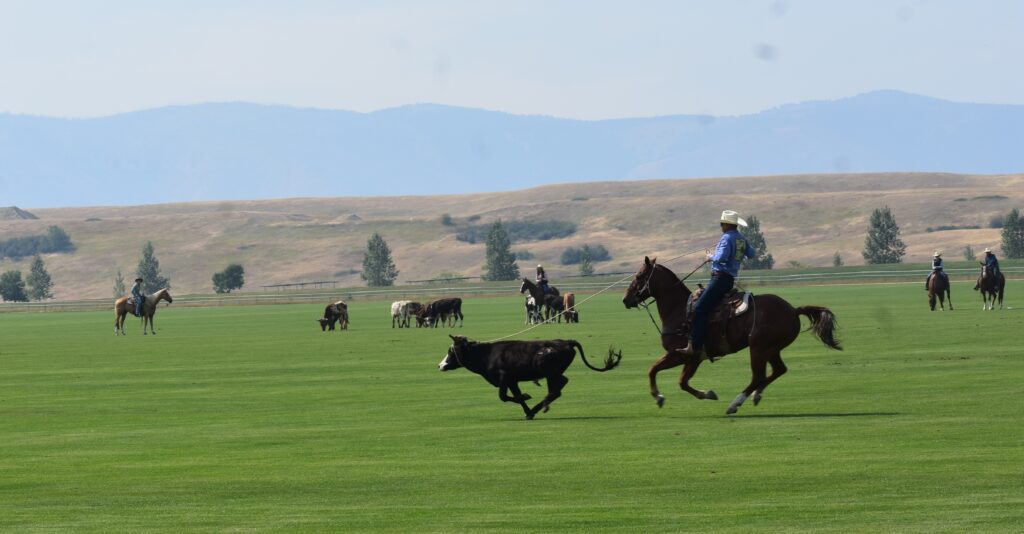
Then a little later the fall roundup will start. This consists of branding all of the calves that were missed on the spring work and the gathering: and holding of the beef cattle to be shipped to market. The work is almost as we have described except that the beef cattle must be herded day and night as they are driving across country to the railroad.
The trailing to the railroad is one of the most important features of the roundup. It must be made in a series of short drives, giving the cattle plenty of time to graze and water so they will be in the best of condition when shipped.
We will revisit the fall roundup in the fall.

